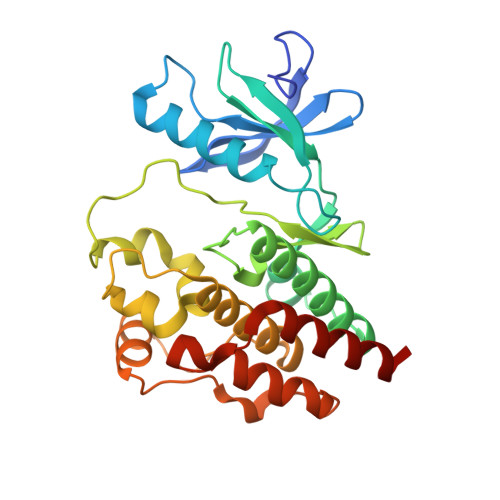Design, synthesis and characterisation of a novel type II B-RAF paradox breaker inhibitor.
Arora, R., Linders, J.T.M., Aci-Seche, S., Verheyen, T., Van Heerde, E., Brehmer, D., Chaikuad, A., Knapp, S., Bonnet, P.(2023) Eur J Med Chem 250: 115231-115231
- PubMed: 36878151
- DOI: https://doi.org/10.1016/j.ejmech.2023.115231
- Primary Citation of Related Structures:
8C7X, 8C7Y - PubMed Abstract:
The mutation V600E in B-Raf leads to mitogen activated protein kinase (MAPK) pathway activation, uncontrolled cell proliferation, and tumorigenesis. ATP competitive type I B-Raf inhibitors, such as vemurafenib (1) and PLX4720 (4) efficiently block the MAPK pathways in B-Raf mutant cells, however these inhibitors induce conformational changes in the wild type B-Raf ( wt B-Raf) kinase domain leading to heterodimerization with C-Raf, causing paradoxical hyperactivation of the MAPK pathway. This unwanted activation may be avoided by another class of inhibitors (type II) which bind the kinase in the DFG-out conformation, such as AZ628 (3) preventing heterodimerization. Here we present a new B-Raf kinase domain inhibitor, based on a phenyl(1H-pyrrolo [2,3-b]pyridin-3-yl)methanone template, that represents a hybrid between 4 and 3. This novel inhibitor borrows the hinge binding region from 4 and the back pocket binding moiety from 3. We determined its binding mode, performed activity/selectivity studies, and molecular dynamics simulations in order to study the conformational effects induced by this inhibitor on wt and V600E mutant B-Raf kinase. We discovered that the inhibitor was active and selective for B-Raf, binds in a DFG-out/αC-helix-in conformation, and did not induce the aforementioned paradoxical hyperactivation in the MAPK pathway. We propose that this merging approach can be used to design a novel class of B-Raf inhibitors for translational studies.
Organizational Affiliation:
Institut de Chimie Organique et Analytique, UMR CNRS-Université d'Orléans 7311, Université d'Orléans BP 6759, 45067, Orléans Cedex 2, France.

















